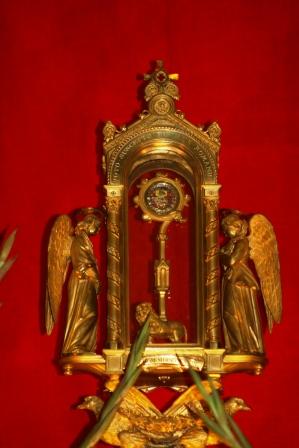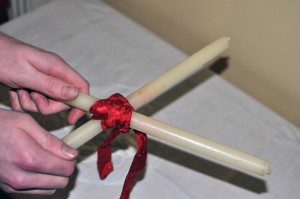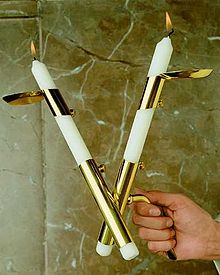 Every time I get my throat blessed on St. Blaise Day, I get a sore throat or bronchitis. Although… this year I have already had it, so I hope I’ve dodged for February.
Every time I get my throat blessed on St. Blaise Day, I get a sore throat or bronchitis. Although… this year I have already had it, so I hope I’ve dodged for February.
Ever the optimist, I keep going back each year for a blessing of the throat.
Tomorrow is the Feast of St. Blaise, about whom we know very little. We have only this very brief entry in the Martyrologium Romanum:
Sancti Blasii, episcopi et martyris, qui pro christiano nomine Sabaste in Armenia passus est sub Licino imperatore. … [Feast of] St. Blaise, bishop and martyr, who suffered for the name of Christ in Sabaste in Armenia under the Emperor Licinus.
That “pro Christiano nomine” probably needs to be rendered as “for the name of Christ” along the lines of rendering dies dominica or oratio dominica as, respectively, “the Lord’s Day = Sunday” or “the Lord’s Prayer”. It is entirely possible, of course, just to keep it literal and say, “for the Christian name”, which would be pretty much the same thing in the balance.
Either way, he was killed because, as a Christian, Blaise professed belief in Christ.
COLLECT:
Exaudi, Domine, populum tuum,
cvm beati Blasii martyris patrocinio supplicantem,
ut et temporalis vitae nos tribuas pace gaudere,
et aeternae reperire subsidium.
LITERAL TRANSLATION:
O Lord, graciously hear Your people
begging by means of the patronage of blessed martyr Blaise,
that you grant us to delight in the peace of temporal life
and obtain the protection of eternal life.
 I take away from this prayer the serious message that life is dangerous.
I take away from this prayer the serious message that life is dangerous.
The word subsidium means “support, assistance, aid, help, protection” and often in liturgical Latin “help”. Either way, subsidium sets up a stark contrast between the life we have now and the life to come. Even the phrase about enjoying the peace of this life, indicates subtly how precarious everything is in this earthly existence which Catholics are accustomed to call a “vale of tears”.
This is firmed up by another wonderful prayer associated with St. Blaise. You all know about the blessing of throats on the feast of St. Blaise. In the older form of the Rituale Romanum there is a marvelous blessing for the candles used to confer the blessing of throats. Here it is:
BLESSING OF CANDLES ON THE FEAST OF ST. BLAISE:
O God most powerful and most kind, Who didst create all the different things in the world by the Word alone, and Whose will it was that this Word by Which all things were made should become incarnate for the remaking of mankind; Thou Who art great and limitless, worthy of reverence and praise, the worker of wonders; for Whose sake the glorious Martyr and Bishop, St. Blaise, joyfully gained the palm of martyrdom, never shrinking from any kind of torture in confessing his faith in Thee; Thou Who didst give to him, amongst other gifts, the prerogative of curing by Thy power every ailment of men’s throats; humbly we beg Thee in Thy majesty not to look upon our guilt, but, pleased by his merits and prayers, in Thine awe-inspiring kindness, to bless+this wax created by Thee and to sanc+tify it, pouring into it Thy grace; so that all who in good faith shall have their throats touched by this wax may be freed from every ailment of their throats through the merit of his suffering, and, in good health and spirits, may give thanks to Thee in Thy holy Church and praise Thy glorious name, which is blessed for ever and ever. Through our Lord, Jesus Christ, Thy Son, Who with Thee lives and reigns, in the unity of the Holy Spirit, God, world without end. R. Amen.
Ah! What a pleasure that prayer is! Or course, the candles are to be sprinkled with holy water after the blessing. Maybe you should print this out and take it to your parish priest “with Fr. Z’s compliments”. It might be that he doesn’t have this text and perhaps would like to (or you would like to) have your throat blessed in Latin!
Here is the Blessing for throats:
Per intercessionem Sancti Blasii, episcopi et martyris, liberet te Deus a malo gutturis, et a quolibet alio malo. In nomine Patris, et Filii +, et Spiritus Sancti. Amen.
Through the intercession of St. Blaise, bishop and martyr,
may God free you from illness of the throat and from any other sort of ill. In the name of the Father, and of the Son + and of the Holy Ghost. Amen.
 I will never forget this formula.
I will never forget this formula.
Long ago, as a deacon, I lived at the Church of San Carlo ai Catinari, which is also dedicated to St. Blaise, San Biagio, as co-patron. The Barnabites there have in their possession relics of St. Blaise. There is one in a large reliquary and one in a crystal placed on a large ring held in the fist of one hand (click the photo to see a larger image and inside the crystal). This is what they used to bless throats on this feast.
I was asked by the clergy there to help with blessing the throats of the people who thronged to the church that day. As soon as I donned my surplice every other cleric actually attached to the place vanished. I was left there for several hours. I can’t say how many times I said that formula that day.
The configuration of the candles used for the blessing can vary. Here are a few examples.
This is probably the most common.
And there is the twisty version:
And then we have a high tech approach: [Last year the nice people at F.C. Ziegler saw this – they make this gizmo – and asked me to post a link to it. Okay! HERE]
Finally, there is this contraption, which looks like it is from Star Trek:
Hmmm….






































A lit candle? Good grief. The risk-assessment side of me is in convulsions.
Based on skin/gut microbiome evidence, illnesses (when allowed to be handled by the body) strengthen the immune system. Maybe the bronchitis is a blessing in disguise?
Keep up the bone broth!
@ Dr. Peters,
Here is how it’s done: https://www.youtube.com/watch?v=VbgLa7IWQyk
Fr Z isn’t the only one who has throat problems after getting his throat blessed ;)
http://catholicmemes.com/etc/intercession-st-blase/
Coming from another culture and not getting the nuances of internet conversation:
Dr Peters, were you serious, or joking?
I don’t know whether the Rituale says the candles must be lit for “effectiveness”, but even if it doesn’t, a St. Blaise’s blessing without lit candles is like a Midnight Mass of Christmas without any Silent Night as well as any Transeamus, something like a Corpus Christi procession without any Te Deum as well as any vernacularization of it; something like Eucharistic adoration without the “Deus qui nobis sub sacramenti mirabili” oration and without its translation to the vernacular too:
that is, something possibly legal, but clearly not the right thing. Sometimes you have to follow tradition.
And looking through two flames appearing just at the fringe of what you can see with either eye certainly does belong to the St. Blaise’s traditions.
[Do you have a problem with giving the blessing while touching a relic of the saint to the person’s throat?]
It’s just different traditions. In the U.S. they usually use shorter, unlighted candles, but the X is put directly under the chin, basically parallel to the floor, where the German tradition uses candles in a plane that is perpendicular to the floor, but lighted.
The ritual says nothing about the candles being lighted. I am referring in particular to a 1946 edition. Perhaps other editions did make such a mention.
Is it permissible to use the English translation of the RR rather than the Latin? If I do I feel like I am being doubly-illicit because I could have used the BoB “correctly” (and therefore insipidly) or the RR correctly in Latin, but the people don’t have the text in front of them and therefore will miss the beauty of the language present in the RR prayer. Even if all-Latin all-the-time is a goal, what to do in the interim?
Dear mpolo,
thanks.
Reverend Father,
no, I would love it; an actual relic of the saint himself present is a special circumstance, as it were.
I would, however, have just a tiny bit of a problem if, instead of a candle and instead of the rather special case with an actual relic, it was given by touching with an image (duly blessed and all) of the saint … if you get my drift.
Pingback: Saint Blaise | CatholicSaints.Info
For me, I like to have the candles actually touch my throat. From the video link, it looks like it’s just a close blessing.
While the ritual may not specify about lighting the candles, the blessing of the candles does say touch.
Our local Pastor asks the Extraordinary Ministers of Holy Communion to assist him with the Blessing of Throats, using pairs of (unlit) candles that he has (presumably?) already blessed. They hold the candles on the person’s throat and then recite the prayer of blessing as shown above (the English version)… Not sure whether the Roman Ritual or Book of Blessings actually authorizes lay people to impart priestly blessings…
The blessing of throats with lighted candles is shown at the end of Mass celebrated at the Basilique Notre-Dame (FSSP) in Fribourg, Switzerland.
Video: http://www.livemass.org/LiveMass/suisseHD.html